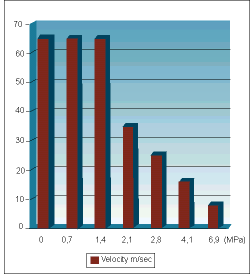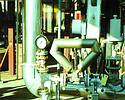
Alpret Control Specialists was awarded the contract for the supply of transmitters and flow-meters for the Mondi Kraft delignification project in Richards Bay. Included in the scope are three Micro Motion Coriolis mass flowmeters to measure the oxygen flow to the pulp stock.
"In selecting Micro Motion mass flowmeters and Rosemount transmitters we can maintain a high degree of plant performance and cost saving through the high accuracy and large turndown that Rosemount and Micro Motion equipment provide"- Henk Coetzee, Instrumentation (Engineer Mondi GTS).
Oxygen is used in the delignification of pulp stock. Exposing wood pulp to oxygen gas removes additional lignins after the Kraft digester - without attacking the wood fibres themselves. Since lignins adversely affect pulp brightness, delignification effectively whitens the pulp stock. In many processes, the pulp stock is bleached using chlorine after the O2 delignification stage. The objective of the overall process is to use less chlorine. Bleaching lignins requires substantial amounts of chlorine, and removing more of the lignins earlier in the process using oxygen is more effective and reduces the amount of chlorine required. The oxygen reactor is essentially a tuned secondary digester.
Accurate control of the oxygen feed gas using a Coriolis from Micro Motion enables good process control - direct mass measurement as well as elimination of routine maintenance was cited by users as valuable attributes.
Brochure G-4.4 from USA Compressed Gas Association is frequently used in the design, installation, and start-up of oxygen gas piping systems. CGA brochures are voluntary guidelines reflecting current industrial practices in the chemical, steel, petroleum, and as such are designed to benefit users in the areas of safety and economic transmission and distribution of gaseous exchange. Selected excerpts from pamphlet G-4.4 will be referenced in this article, specifically as applied to coriolis measurement of oxygen gas. It is suggested that pamphlet G-4.4 be consulted in its entirety for additional guidelines beyond the scope of this article.
Sizing and selection:
Sizing and selection of flow meters for oxygen service is virtually identical to sizing other Coriolis gas meters. The two primary criteria are acceptable pressure drop and desired accuracy over the flow range of interest. Maximum recommended velocity per CGA Pamphlet G-4.4 can modify the flowmeter size selected, and cleaning is frequently an end user consideration. The Windows-based MMI WIN sizing program greatly facilitates sizing and selection of the oxygen gas flowmeter. User-entered variables include flow rate, operating pressure, and temperature.
The final selection is based on allowable pressure drop, desired accuracy, and velocity. Micro Motion's Elite flowmeter is preferred for gas service (although numerous D-model flowmeters have been used in the past), and are preferentially selected by the sizing program. With sizes ranging from the 1/4" (6 mm) model CMF025 to the 3" (80 mm) model CMF300, oxygen flow rates from virtually zero to approximately 7000 scfm (600 lb/min) or 12 x 106NM3/h (16 kg/h) can be measured using a single flowmeter (following the CGA velocity guidelines). For higher flow rates, two or more CMF300 sensors can be installed in parallel.
CGA velocity guidelines are shown in Figure 1. Per CGA, pipe size should be selected to adhere to the maximum recommended velocity as a function of gas pressure. This is based on typical stainless steel piping. CGA guidelines also include information on system components such as flowmeters, where due to practical sizing concerns, the piping velocity guidelines may be exceeded.
The CGA suggests that upstream filters be considered to remove particulate material. This prevents impingement and possible sparking. Impingement of particulates (weld slag, bits of corrosion, of rust particles) at high velocity is thought to create sparking, and is therefore a source of ignition energy. In the presence of combustible particulate material, this can initiate the accumulation of fibres inside the piping.

Oxygen service cleaning is frequently specified by the end-user and is intended to eliminate sources of combustible material inside the piping. When internal organic, inorganic, and particulate matter is removed, a system is generally considered clean for oxygen service.
So oxygen is a commonly measured, valuable industrial gas and is used in a wide variety of processes. Reliable, accurate flow measurement is critical to ensuring safety of plant personnel quality, and maximum yield. Existing volumetric technologies such as dP, turbine, and vortex are limited by turndown, accuracy, and reliability. Thermal mass meters have often been used, but are somewhat maintenance-intensive and have the tendency to drift with ambient temperature changes.
More recently, Coriolis meters from Micro Motion have been used in oxygen service with excellent results. With useable turndown of 100:1 and excellent accuracy over a 60:1 operation density range, Coriolis meters from Micro Motion also eliminate straight-run requirements and routine maintenance. Direct mass measurements, synonymous with standard or normal volumetric units, are fundamentally more accurate, and eliminate the need for correction in factors based on pressure and temperature. Installation is simple and straightforward, with no requirements for flow conditioning.

With an installed base of over 150 000 flow and density sensors worldwide, Micro Motion can provide the measurement expertise and support required in any application. Third party testing, and more than 7500 gas-phase applicants around the world, have demonstrated the benefits of using Micro Motion Coriolis technology to measure oxygen gas.
The sensors are easy to install and maintain. No straight pipe-runs or filters/strainers required. They are insensitive to swirl effects and can be installed in horizontally or vertical pipe runs, providing potential for cost savings from simple installation requirements.
Alpret Control Specialists
(011) 249 6700

© Technews Publishing (Pty) Ltd | All Rights Reserved